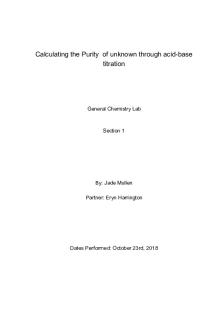Acid Base Titration Worksheet-calculations including molar concentration and neutralization point PDF

| Title | Acid Base Titration Worksheet-calculations including molar concentration and neutralization point |
|---|---|
| Author | Yalindi Narangoda |
| Course | AP Chemistry |
| Institution | High School - USA |
| Pages | 2 |
| File Size | 65.3 KB |
| File Type | |
| Total Downloads | 84 |
| Total Views | 146 |
Summary
acid-base titration worksheet with calculations. Acid Base Titration Worksheet-calculations including molar concentration and neutralization point. Includes strong acid and strong base titrations....
Description
Titrations Practice Worksheet Find the requested quantities in the following problems: 1)
If it takes 54 mL of 0.1 M NaOH to neutralize 125 mL of an HCl solution, what is the concentration of the HCl?
2)
If it takes 25 mL of 0.05 M HCl to neutralize 345 mL of NaOH solution, what is the concentration of the NaOH solution?
3)
If it takes 50 mL of 0.5 M KOH solution to completely neutralize 125 mL of sulfuric acid solution (H2SO4), what is the concentration of the H2SO4 solution?
4)
Can I titrate a solution of unknown concentration with another solution of unknown concentration and still get a meaningful answer? Explain your answer in a few sentences.
5)
Explain the difference between an endpoint and equivalence point in a titration.
http://www.chemfiesta.com
Solutions to the Titrations Practice Worksheet For questions 1 and 2, the units for your final answer should be “M”, or “molar”, because you’re trying to find the molarity of the acid or base solution. To solve these problems, use M1V1 = M2V2. 1) 2)
0.043 M HCl 0.0036 M NaOH
For problem 3, you need to divide your final answer by two, because H2SO4 is a diprotic acid, meaning that there are two acidic hydrogens that need to be neutralized during the titration. As a result, it takes twice as much base to neutralize it, making the concentration of the acid appear twice as large as it really is. 3)
0.1 M H2SO4
4) You cannot do a titration without knowing the molarity of at least one of the substances, because you’d then be solving one equation with two unknowns (the unknowns being M1 and M2). 5) Endpoint: When you actually stop doing the titration (usually, this is determined by a color change in an indicator or an indication of pH=7.0 on an electronic pH probe) Equivalence point: When the solution is exactly neutralized. It’s important to keep in mind that the equivalence point and the endpoint are not exactly the same because indicators don’t change color at exactly 7.0000 pH and pH probes aren’t infinitely accurate. Generally, you can measure the effectiveness of a titration by the closeness of the endpoint to the equivalence point.
http://www.chemfiesta.com...
Similar Free PDFs

Acid Base Titration
- 7 Pages

Acid Base Titration
- 15 Pages

Acid Base Titration
- 6 Pages

Afl Acid-Base Titration
- 6 Pages

Acid base titration lab report
- 5 Pages

Acid-Base Titration Lab Report
- 7 Pages

Exp 08 Acid-Base Titration
- 10 Pages

Neutralization Titration
- 6 Pages

Acid Base Titration 08 2019
- 11 Pages

Acid-Base Titration Pre-Lab
- 4 Pages
Popular Institutions
- Tinajero National High School - Annex
- Politeknik Caltex Riau
- Yokohama City University
- SGT University
- University of Al-Qadisiyah
- Divine Word College of Vigan
- Techniek College Rotterdam
- Universidade de Santiago
- Universiti Teknologi MARA Cawangan Johor Kampus Pasir Gudang
- Poltekkes Kemenkes Yogyakarta
- Baguio City National High School
- Colegio san marcos
- preparatoria uno
- Centro de Bachillerato Tecnológico Industrial y de Servicios No. 107
- Dalian Maritime University
- Quang Trung Secondary School
- Colegio Tecnológico en Informática
- Corporación Regional de Educación Superior
- Grupo CEDVA
- Dar Al Uloom University
- Centro de Estudios Preuniversitarios de la Universidad Nacional de Ingeniería
- 上智大学
- Aakash International School, Nuna Majara
- San Felipe Neri Catholic School
- Kang Chiao International School - New Taipei City
- Misamis Occidental National High School
- Institución Educativa Escuela Normal Juan Ladrilleros
- Kolehiyo ng Pantukan
- Batanes State College
- Instituto Continental
- Sekolah Menengah Kejuruan Kesehatan Kaltara (Tarakan)
- Colegio de La Inmaculada Concepcion - Cebu





